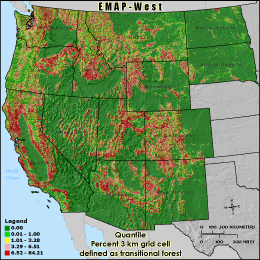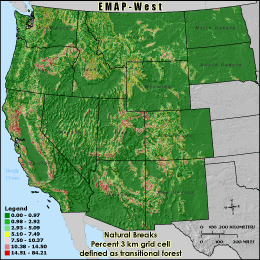|
|
Methodology and Interpretation
PFTRAN9 - Percent 3 km grid cell defined as transitional forest
Percent transitional forest is calculated using a moving 270 meter
square window (9 pixels x 9 pixels) across the land cover. When the percent
forest in the window is greater than 40%, but less than 60%, the forest cell in
the center of the window is categorized as transitional. The number of
transitional forest cells in the 3 km grid cell reporting unit is then divided
by the grid cell's total land area (the total number cells in the grid cell boundary
minus those cells classified as water) to derive PFTRAN9. Transitional forest is
unlikely to be connected across an area, although it is possible. It is also unlikely
to provide interior habitat.


Quantile: Each class contains an approximately equal number (count) of features. A quantile
classification is well-suited to linearly distributed data. Because features are grouped by the number
within each class, the resulting map can be misleading, in that similar features can be separated into
adjacent classes, or features with widely different values can be lumped into the same class. This
distortion can be minimized by increasing the number of classes.
Natural Breaks: Classes are based on natural groupings of data values. Natural break points
are identified by looking for groupings and patterns inherent in the data. The features are divided
into classes whose boundaries are set where there are relatively large jumps in the distribution of
data values.
* EMAP-West Landscape Metrics Metadata (FGDC)
|
|

